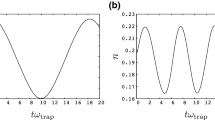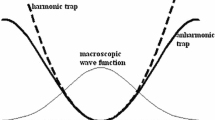Abstract
We investigate the behaviour of a two-component Fermi superfluid in a double-well potential. We numerically solve the time dependent Bogoliubov-de Gennes equations and characterize the regimes of Josephson oscillations and self-trapping for different potential barriers and initial conditions. In the weak link limit the results agree with a two-mode model where the relative population and the phase difference between the two wells obey coupled nonlinear Josephson equations. A more complex dynamics is predicted for large amplitude oscillations and large tunneling.











Similar content being viewed by others
References
B.D. Josephson, Phys. Lett. 1, 251 (1962)
A. Barone, G. Paterno, Physics and Applications of the Josephson Effect (Wiley, New York, 1982)
A.J. Leggett, Rev. Mod. Phys. 73, 307 (2001)
L. Pitaevskii, S. Stringari, Bose–Einstein Condensation (Oxford Science Publications, Oxford, 2003)
R. Gati, M.K. Oberthaler, J. Phys. B 40, R61 (2007)
A. Smerzi, S. Fantoni, S. Giovanazzi, S.R. Shenoy, Phys. Rev. Lett. 79, 4950 (1997)
S. Raghavan, A. Smerzi, S. Fantoni, S.R. Shenoy, Phys. Rev. A 59, 620 (1999)
E.A. Ostrovskaya, Y.S. Kivshar, M. Lisak, B. Hall, F. Cattani, D. Anderson, Phys. Rev. A 61, 031601R (2000)
D. Ananikian, T. Bergeman, Phys. Rev. A 73, 013604 (2006)
F.S. Cataliotti, S. Burger, C. Fort, P. Maddaloni, F. Minardi, A. Trombettoni, A. Smerzi, M. Inguscio, Science 293, 843 (2001)
Th Anker, M. Albiez, R. Gati, S. Hunsmann, B. Eiermann, A. Trombettoni, M.K. Oberthaler. Phys. Rev. Lett. 94, 020403 (2005)
M. Albiez, R. Gati, J. Foelling, S. Hunsmann, M. Cristiani, M.K. Oberthaler, Phys. Rev. Lett. 95, 010402 (2005)
T. Zibold, E. Nicklas, Ch. Gross, M.K. Oberthaler, Phys. Rev. Lett. 105, 204101 (2010)
S. Levy, E. Lahoud, I. Shomroni, J. Steinhauer, Nature 449, 579 (2007)
L.J. LeBlanc, A.B. Bardon, J. McKeever, M.H.T. Extavour, D. Jervis, J.H. Thywissen, F. Piazza, A. Smerzi, Phys. Rev. Lett. 106, 025302 (2011)
P. Pieri, G.C. Strinati, Phys. Rev. Lett. 91, 030401 (2003)
A. Spuntarelli, P. Pieri, G.C. Strinati, Phys. Rev. Lett. 99, 040401 (2007)
A. Spuntarelli, P. Pieri, G.C. Strinati, Phys. Rep. 488, 111 (2010)
F. Ancilotto, L. Salasnich, F. Toigo, Phys. Rev. A 79, 033627 (2009)
L. Salasnich, N. Manini, F. Toigo, Phys. Rev. A 77, 043609 (2008)
L. Salasnich, F. Ancilotto, N. Manini, F. Toigo, Laser Phys. 19, 636 (2009)
S.K. Adhikari, H. Lu, H. Pu, Phys. Rev. A 80, 063607 (2009)
G. Watanabe, F. Dalfovo, F. Piazza, L.P. Pitaevskii, S. Stringari, Phys. Rev. A 80, 053602 (2009)
S. Giorgini, L. Pitaevskii, S. Stringari, Rev. Mod. Phys. 80, 1215 (2008)
P.G. de Gennes, Superconductivity of Metals and Alloys (Benjamin, New York, 1966)
A.J. Leggett, Modern Trends in the Theory of Condensed Matter, ed by A Pekalski, R, Przystawa (Springer-Verlag, Berlin, 1980)
M. Randeria, Bose Einstein Condensation, ed by A. Griffin, D. Snoke, S. Stringari (Cambridge, Cambridge, England, 1995)
K.J. Challis, R.J. Ballagh, C.W. Gardiner, Phys. Rev. Lett. 98, 093002 (2007)
R.G. Scott, F. Dalfovo, L.P. Pitaevskii, S. Stringari, Phys. Rev. Lett. 106, 185301 (2011)
A. Bulgac, Y. Yu, Phys. Rev. Lett. 88, 042504 (2002)
M. McNeil Forbes, R. Sharma, arXiv:1308.4387
R. Combescot, M.Y. Kagan, S. Stringari, Phys. Rev. A 74, 042717 (2006)
M. Antezza, F. Dalfovo, L.P. Pitaevskii, S. Stringari, Phys. Rev. A 76, 043610 (2007)
R. Liao, J. Brand, Phys. Rev. A 83, 041604(R) (2011)
F. Piazza, L.A. Collins, A. Smerzi, Phys. Rev. A 81, 033613 (2010)
Acknowledgments
We thank S. Stringari, L.P. Pitaevskii, A. Recati for fruitful discussions. P.Z is particularly indebted to R.G.Scott, whose computational expertise was of great help at the beginning of this work. Support of ERC, through the QGBE Grant, and of Provincia Autonoma di Trento is acknowledged.
Author information
Authors and Affiliations
Corresponding author
Appendix: Calculation of the Energy Difference \(\Delta E\)
Appendix: Calculation of the Energy Difference \(\Delta E\)
In this appendix we provide some details about the calculations of the energy difference, \(\Delta E=E^--E^+\), where \(E^+\) is the energy of the (symmetric) ground state of the gas and \(E^-\) is the energy of the lowest anti-symmetric state with the same number of particles \(N\) in the box. Here symmetric and anti-symmetric refer to spatial reflection in the \(x\)-direction around \(x=0k_F^{-1}\). The anti-symmetric state corresponds to the solutions of Eq. (1) exhibiting a \(\pi \) phase jump in the order parameter \(\Delta \) when crossing the center of the box. For weakly coupled superfluids the quantity \(\Delta E\) is directly related to the Josephson tunnelling energy, \(E_J\) as already seen in Sect. 4.
Left energy difference \(\Delta E=E^--E^+\), divided by the area \(L_\perp ^2\), as a function of the barrier height \(V_0\) for different widths \(d\). Right the same quantity as a function of the barrier width \(d\) for different values of height \(V_0\). All the other parameters are the same as in the previous figure (Color figure online)
Since the quantity \(\Delta E\) is typically much smaller than the energies \(E^-\) and \(E^+\), we must take care of all possible sources of numerical inaccuracy, in particular those introduced by the finite cutoff energy and the finite box. We have first checked that, at unitarity, without barrier and in the limit of large \(L\), the energy \(E^+\) converges to the energy of a uniform infinite gas: \((E^+/N)= (3/5)\mu = (3/5)(1+\beta )E_F= 0.354 E_F\), where \(\beta =-0.41\) is the value of the Bertsch parameter in BdG theory [24]. In the same situation, the quantity \(\Delta E\) measures the cost in energy associated to creation of the density depletion and the nodal structure of the order parameter at the box center, corresponding to a dark soliton [33]. The energy per unit surface of a planar dark soliton at unitarity is \(\epsilon _s=\Delta E/ (E_F k_F^2 L_\perp ^2)\) and BdG theory gives \(\epsilon _s=(1+\beta )^{1/2}/(8\pi \sqrt{3}) \simeq 0.0176\) [34]. We have checked that both analytic values are reproduced within an accuracy of about \(2\) %, which is enough for our purposes.
Our results for \(\Delta E\) as a function of \(V_0\) and \(d\) are shown in Figs. 12 and 13. All results in these figures are obtained by using \(N=156\), \(L_{\perp }=13k_{F}^{-1}\), \(L=30k_{F}^{-1}\), and \(E_\mathrm{cut}=70E_{F}\). As expected, \(\Delta E\) approaches the same value in the limit of vanishingly small barrier (i.e, for \(V_0 \rightarrow 0\) at finite \(d\)). This value is \(\Delta E/(k_F^2L_\perp ^2E_F)\simeq 0.0185\), which is slightly larger than the energy of dark soliton in an infinite system, due to the finite box sixe. For \(d\) of the order of \(k_F^{-1}\), the quantity \(\Delta E\) is rapidly decreasing when \(V_0\) increases. The case of large barriers and small tunnelling (weak link) is where the physics of the Josephson effect is expected to manifest.
Finally we note that for \(V_0\) much smaller than \(E_F\) the quantity \(\Delta E\) tends to be a constant value when \(d \rightarrow \infty \). A simple explanation of this behavior is obtained by considering that, for a very wide and low barrier, the effect of the barrier is that of lowering the “bulk” density in the central region of the box. If \(d\) is larger that the soliton width, which is of the order of a few \(k_F^{-1}\), this effect can be accounted for by calculating the energy of a dark soliton in uniform gas of reduced density. Further increasing the width of the barrier has no effects on the soliton energy and hence \(\Delta E\) remains constant.
Rights and permissions
About this article
Cite this article
Zou, P., Dalfovo, F. Josephson Oscillations and Self-Trapping of Superfluid Fermions in a Double-Well Potential. J Low Temp Phys 177, 240–256 (2014). https://doi.org/10.1007/s10909-014-1209-2
Received:
Accepted:
Published:
Issue Date:
DOI: https://doi.org/10.1007/s10909-014-1209-2






